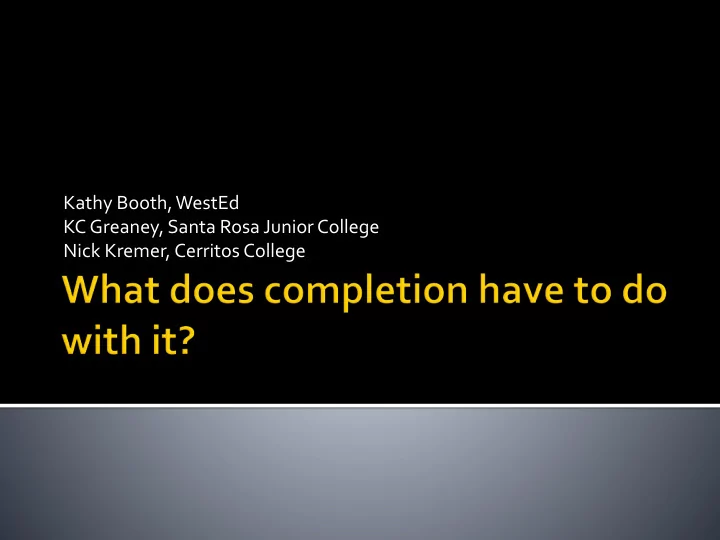

Kathy Booth, WestEd KC Greaney, Santa Rosa Junior College Nick Kremer, Cerritos College
“I have lots of students who take a couple of courses and then they go and get a job before they complete the program. How can they be failures?” “Sure students complete. They just complete someone else’s credential.”
Understand current research efforts to document outcomes for students who don’t complete a community college credential or transfer Evaluate implications of research for community college policy and practice
CTE Employment Outcomes Survey Peter Bahr’s Research • Filed driven by CTE Deans • The goal was to understand what students actually do in community • “Scaled up” to statewide survey, with colleges, by examining course-taking nearly a third of California Community patterns , course-success, and Colleges participating completion of credentials or transfer. • Goal: obtain data and information not available elsewhere primarily to answer these questions: Are students finding jobs, and in the fields for which they trained? Do they see a wage increase?
CTE Employment Outcomes Survey Peter Bahr’s Research • Using the Chancellor’s Office statewide • Surveys conducted through email, US database, Bahr conducted a cluster mail, and by phone. analysis of course-taking behaviors , with the surprise finding that a large • Responses paired with student number of students were taking only one information available through a or two courses, succeeding in these statewide system database classes, but not getting a credential or transferring. • Further analysis refined a skills-builder cohort for further study, mapped common course topics, and linked course-taking with wage data from the state unemployment database.
CTE Employment Outcomes Survey Peter Bahr’s Research • Certificate/vocational degree earners The second phase research on programs • Students who completed 9 or more CTE of study and wage gains for short-term units and did not enroll in the following course-takers included 174,864 students year who met the following criteria: • first-time students • 35 colleges participated; 47,436 students • between the age of 18 and 50 • took six or fewer credits were surveyed, 24% (11,595) responded • achieving a unit success rate of at • “Skills Builders” are a sub -set, defined as least 70% • did not secure a community college non-completers who did not transfer to a 4-year institution credential or transfer to a four-year college
CTE Employment Outcomes Survey Peter Bahr’s Research • Research was conducted in the first half • Course-taking behavior and academic of 2013, for students who met the criteria outcomes were observed for six years, during the 2010-2011 school year. covering students who began taking courses between fall 2002 and summer 2006 . • Wage data tracked students from eight quarters prior to their college entry through the fourth quarter of 2012.
CTE Employment Outcomes Survey Peter Bahr’s Research SUCCESSFUL: FAST: Three-fifths stayed just one • 27% have earned a BA/BS or higher semester, and most left after two • 11% self-employed terms • 31% obtained industry certification/licensure EFFECTIVE: Skills-builders are • Posted higher pre-and post-wages extremely successful in their compared to other groups in the coursework • survey unit success rate of 98% • 71% earning a GPA of 3.0 or UNIQUE: higher (compared to 28%) • 26% had ed goal of update job skills/renew license or permit NON-TRADITIONAL: 37 years old, 51% • 13% had ed goal of self-enrichment male, 47% white, 33% Latino, 7% African American, and 7% Asian NON-TRADITIONAL: 37 years old American
CTE Employment Outcomes Survey Peter Bahr’s Research About three-fifths (58%) of skills-builder Unknown, as they did not complete a students enrolled initially in CTE fields program of study such as: • engineering and industrial technologies • business and management • public and protective services • family and consumer sciences • information technology
CTE Employment Outcomes Survey Peter Bahr’s Research 16 of the 24 non-completing course YES: clusters yielded significant earnings gains • 22% increase in hourly wages from for students, usually in the 5-10% range prior to coursework/training to for just six credits : approximately 1.5 years post • coursework/training administration of justice – 9% earnings gain • electronics and electric technology – 8% earnings gain • computer infrastructure and support – 5% earnings gain • child development & early care education – 3% earnings gain The more credits non-completers took, the more their wages increased .
CTE Employment Outcomes Survey Peter Bahr’s Research The unemployment insurance data • 16.3% report they learned skills to stay doesn’t tell us in their current job • 31% obtained an industry certification/licensure • 45% report their current job is “very close” to their field of study • 22% report their current job is “close” to their field of study
In addition to the studies described here, research by the California Community College Chancellor’s Office found: Positive wage gains for non-completing students who listed “improving skills” as their college goal Similar demographics (including a high rate of returning students) Similar course-taking patterns
Skills-builder students are not just anecdotes. These students appear to upgrading work- related competencies, not taking personal enrichment classes, and securing significant wage gains. Common success metrics count these students as failures. Few colleges have access to employment, wage, and external certification data needed to demonstrate their successes.
1) Metrics are needed to capture community college workforce development goals. Some measures that may prove helpful include: Course success Employment Job retention Wage gain Industry certifications and state licenses
2) Looking at employment outcomes can help colleges determine whether they are offering students a fair return on investment and a chance at a family-sustaining wage.
3) Colleges could leverage information on skills- builder students to inform program improvement efforts. What are some of the ways that you think this information would be useful at your own institution?
CTE Employment Outcomes Survey: [URL] Peter Bahr’s Research on Skills -builders, plus practitioner-friends guides to support conversations on the research: www.wested.org/project/quantifying-non- completion-pathways-to-success Contact us! Nick Kremer: nkremer@cerritos.edu KC Greaney: kgreaney@santarosa.edu Kathy Booth: kbooth@wested.org
Recommend
More recommend